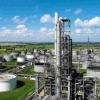My professor has not been helpful at all on this subject. I am designing a heat exchanger that will heat a liquid (ethanol/water) to boiling and then partially vaporize it. The quality of the exiting mixture will be less than .02. I plan to place that fluid on the shell side of a horizontal 1-1 shell and tube heat exchanger, with the hot fluid in the tubes not undergoing a phase change.
I have been advised to visualize the exchanger as two separate ones, one to heat and one to boil, and then to add the areas together to get a total area. For the heating exchanger I plan to use the Donohue equation, but I am lost as to what correlation to use to determine the heat transfer coefficient in the section of the exchanger that is boiling.
Looking through Perry's I see a bunch of correlations but I don't understand which of them would be fitting. 15% of the total exchanger duty is going towards boiling, so I am wary about assuming the coefficient to be the same as that for the other section.
|
|
Heat Transfer To Boiling Liquid
Started by donthurtme, Sep 12 2007 02:08 AM
3 replies to this topic
Share this topic:
#1

Posted 12 September 2007 - 02:08 AM
#2

Posted 12 September 2007 - 12:32 PM
Hurtin’:
Before you start to put any pencil to paper – or even less, crank up a computer – to resolve this problem, take the time to have a cup of coffee and think about what you have written.
- You are proposing to heat a liquid fluid that is a mixture of water and ethanol;
- You plan to heat the fluid inside the shell of a shell & tube heat exchanger;
- The tubeside heating fluid is a liquid;
- You intend to heat the liquid to its boiling point and also partially vaporize it within the heat exchanger;
- You visualize the heat transfer operation as taking place in two steps: first you add sensible heat and then you add the latent heat;
- You propose to calculate the required area for the sensible heat transfer as well as the latent heat transfer area and add both areas to get the required overall heat exchanger area.
This can’t work - and I mean safely and practically. It can’t work physically because you haven’t considered the fact that you need a vapor disengagement volume to absorb and contain the produced vapor within the exchanger. You haven’t said it, but you have inferred that you will run the exchanger 100% liquid full, under steady state. That means that the fluid is traveling within the shell and gathering heat as it heats up to its boiling point. There is no conceivable (or credible) way that you can calculate the volume (and length) of the shell side that permits the liquid to reach its boiling point at the precise moment when it reaches the outlet nozzle on the shell. Even Houdini couldn’t pull that off. What you are lacking is the proper piece or type of equipment to do what you propose. You require something resembling a reboiler – either a kettle type or a thermosyphon. But either way, you will have two fluids generated and that means you require two outlets – you can’t force both fluids to exit together through the same nozzle as a 2-phase. This would jeopardize the operation with a very credible and dangerous hazard: a rapid pressure excursion within the exchanger shell. Boilers or evaporators – any apparatus that adds latent heat to a liquid – must have a method of absorbing the compressible vapor to disengage and also absorb some of the sudden pressure that can build up due to vapor generation. That’s why these “phase changers” have a vapor dome or a vapor space above the boiling liquid. Otherwise, the pressure buildup would be too rapid and could seriously damage the vessel. That’s why you can’t afford to generate a vapor in a liquid-full vessel. It's all about vapor pressure and its generation.
If you need to generate a saturated fluid – or even a boiling fluid with some vapor – then do it the way we handle the problem out in industry: heat the 100% liquid under pressure and then flash the superheated liquid into a flash drum where the saturated liquid is separated from the generated vapor. The vapor exits the top of the drum, and the liquid goes out the bottom. This way, you calculate the heat transfer as a normal liquid-to-liquid film coefficient under pressure.
Out of pure curiosity, who thought up this hazardous idea to generate vapor? Was it you? I hope your professor wasn’t a party to it. That's probably why he/she isn't of much help on this idea. Someone could get seriously hurt building something like that. I strongly advise you not to think of trying to do a vaporization in that manner. You could wind up Hurtin' For Certain.
#3

Posted 12 September 2007 - 02:05 PM
That's a very valid point about pressure building up. This is the method our professor suggested though. In the beginning of the project someone suggested creating a saturated liquid in the proposed exchanger and his response was "Why stop there?" It was his suggestion to create a vapor within the same exchanger to maximize the total amount of heat transferred. (the main goal of the project is to design a new heat exchanger that will recycle heat from a waste stream in order to save steam, giving us a yearly savings and a capital cost and thus allowing for a quick economic optimization)
I also found a link to this very website which suggests the same method.
http://www.cheresour...esignexzz.shtml
It had actually been my second thought to design an exchanger to create a saturated liquid on the cold side and then a reboiler to create the vapor, with the hot fluid flowing through the reboiler first and then the exchanger. (my first thought was to redirect some streams and use an exchanger already present, but that wasn't a road he wanted me going down) Now I'm stuck between doing what my professor has asked or doing what is physically more sound...
I also found a link to this very website which suggests the same method.
http://www.cheresour...esignexzz.shtml
It had actually been my second thought to design an exchanger to create a saturated liquid on the cold side and then a reboiler to create the vapor, with the hot fluid flowing through the reboiler first and then the exchanger. (my first thought was to redirect some streams and use an exchanger already present, but that wasn't a road he wanted me going down) Now I'm stuck between doing what my professor has asked or doing what is physically more sound...
#4

Posted 12 September 2007 - 07:38 PM
Hurtin’:
I will be very frank with you when it comes to a safety hazard or flawed engineering: don’t do it or sponsor it.
You may be correct in saying that it is your Prof that has decided what you must do, but you still have free will and a right to challenge any design that isn’t considered good, safe engineering practice. The factual truth is that boilers, evaporators, and vaporizers are never built as in-line latent heat transfer apparatus. They require a vapor cushion and disengagement space/volume. To try to use a conventional one-pass shell/one-pass tube shell & tube exchanger as a vaporizer is to invite an accident. You haven’t given us any hard, basic data such as temperatures, fluids, pressures, heat transfer areas, velocities, etc. etc.. Consequently, all that you have written up to now is basically academic. If it stays at that level, you’re safe. You also have not told us where you are and what university you attend. It could very well be that your Prof is merely testing you to find out if you’ll fall for the trap. There’s a lot of things here that we don’t know.
However, I do know this: You are wrong when you write that the article posted in http://www.cheresour...esignexzz.shtml advocates the generation of vapor inside a heat exchanger. It never mentions that at all. What it does do is reflect how a CONDENSER can be designed by breaking up the different types of heat loads occurring. That is a totally different example! A condenser forms one, single phase fluid as an exiting product; a boiler produces the contrary as it takes a liquid and converts it into TWO exiting product streams – one a compressible fluid.
Your idea of recovering more heat efficiently by running the hot, waste fluid through a reboiler kettle and subsequently using it as a pre-heat source for the water feed to the same reboiler makes good sense. This is how waste heat boilers are built and employed in industry. Why you are having problems with your Prof is something only you can answer. I would challenge the use of a shell & tube exchanger as you have described it under the basis that it is unsafe and considered bad and flawed design. There is no method known by me as to how to calculate the required heat transfer area for such a device. Heat transfer is bad enough in a submerged coil without going into 2-phase flow inside the shell of a baffled heat exchanger. It just isn’t done because it is inefficient and unsafe – as well as being next to impossible to control.
Sorry to have to tell you the bare facts.
Similar Topics
Steam Pressure In Heat ExchangerStarted by Guest_mvanrijnbach_* , 15 Apr 2025 |
|

|
||
Liquid Liquid Separator SizingStarted by Guest_Kentucky08_* , 03 Apr 2025 |
|

|
||
Heat Exchanger Steam FlowStarted by Guest_aliebrahem17_* , 25 Nov 2024 |
|

|
||
Steam Carrying Liquid From The Sour Water Stripping TowerStarted by Guest_kaidlut_* , 12 Sep 2024 |
|

|
||
Modeling Liquid Metals In Aspen PlusStarted by Guest_AnthonyB_* , 03 Apr 2025 |
|

|

 FB
FB







